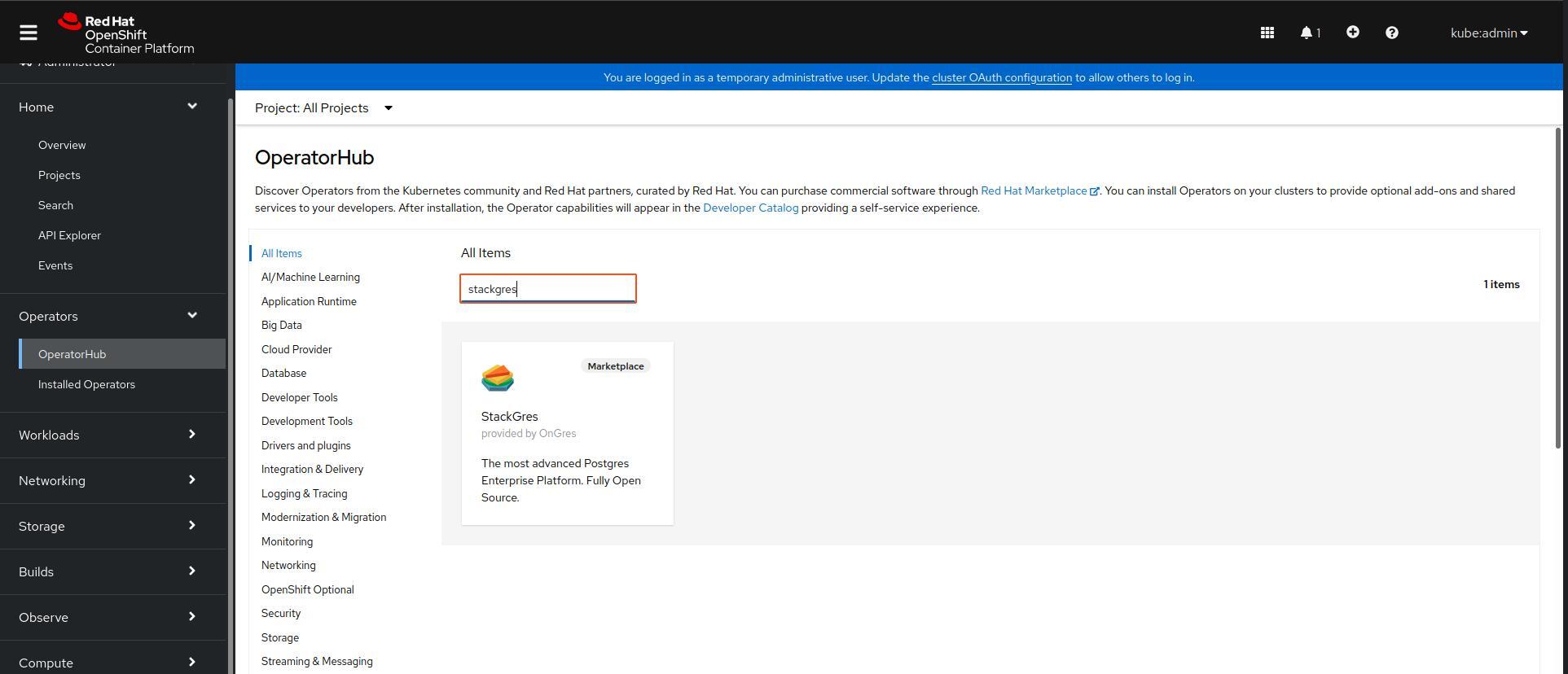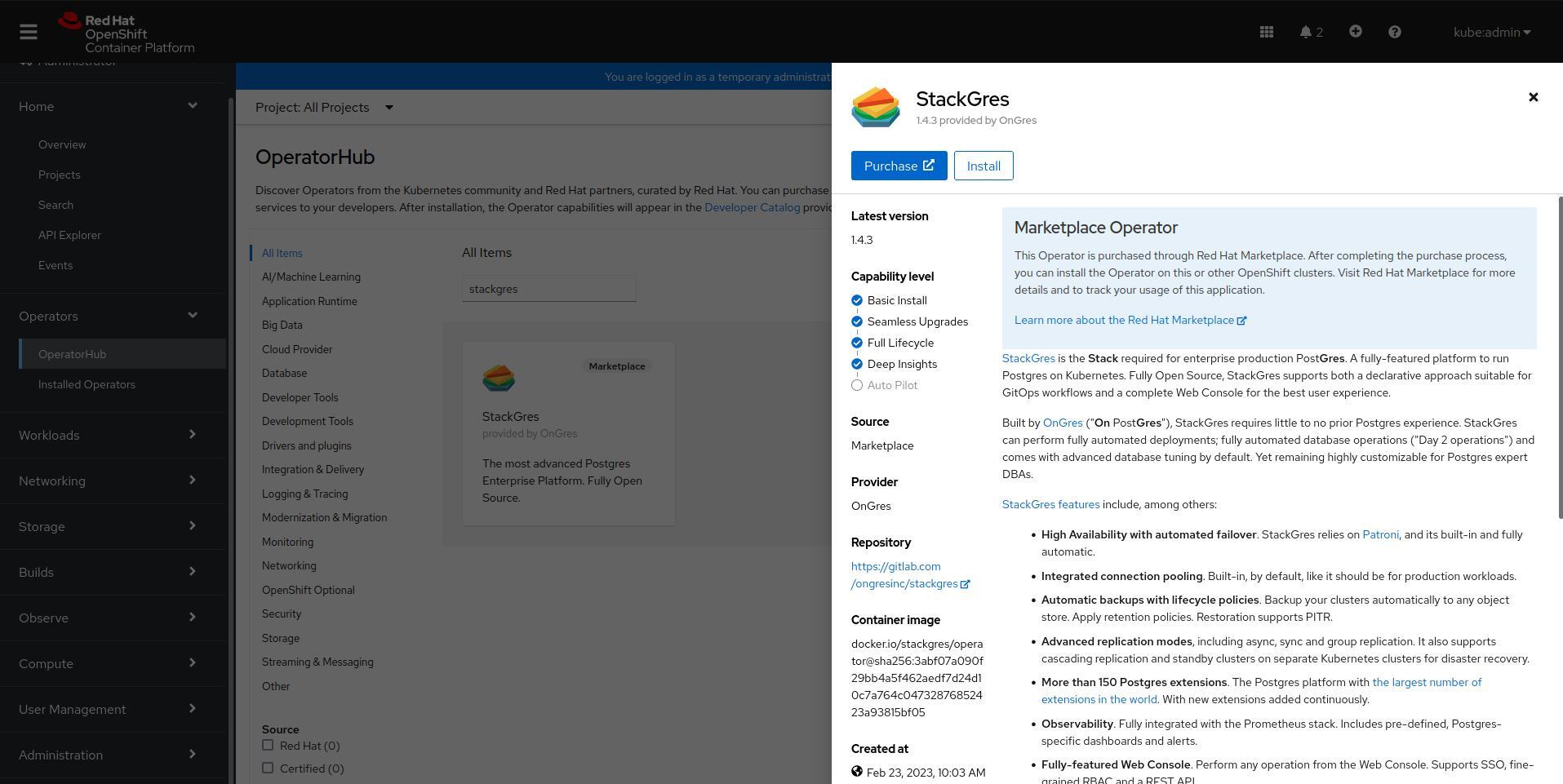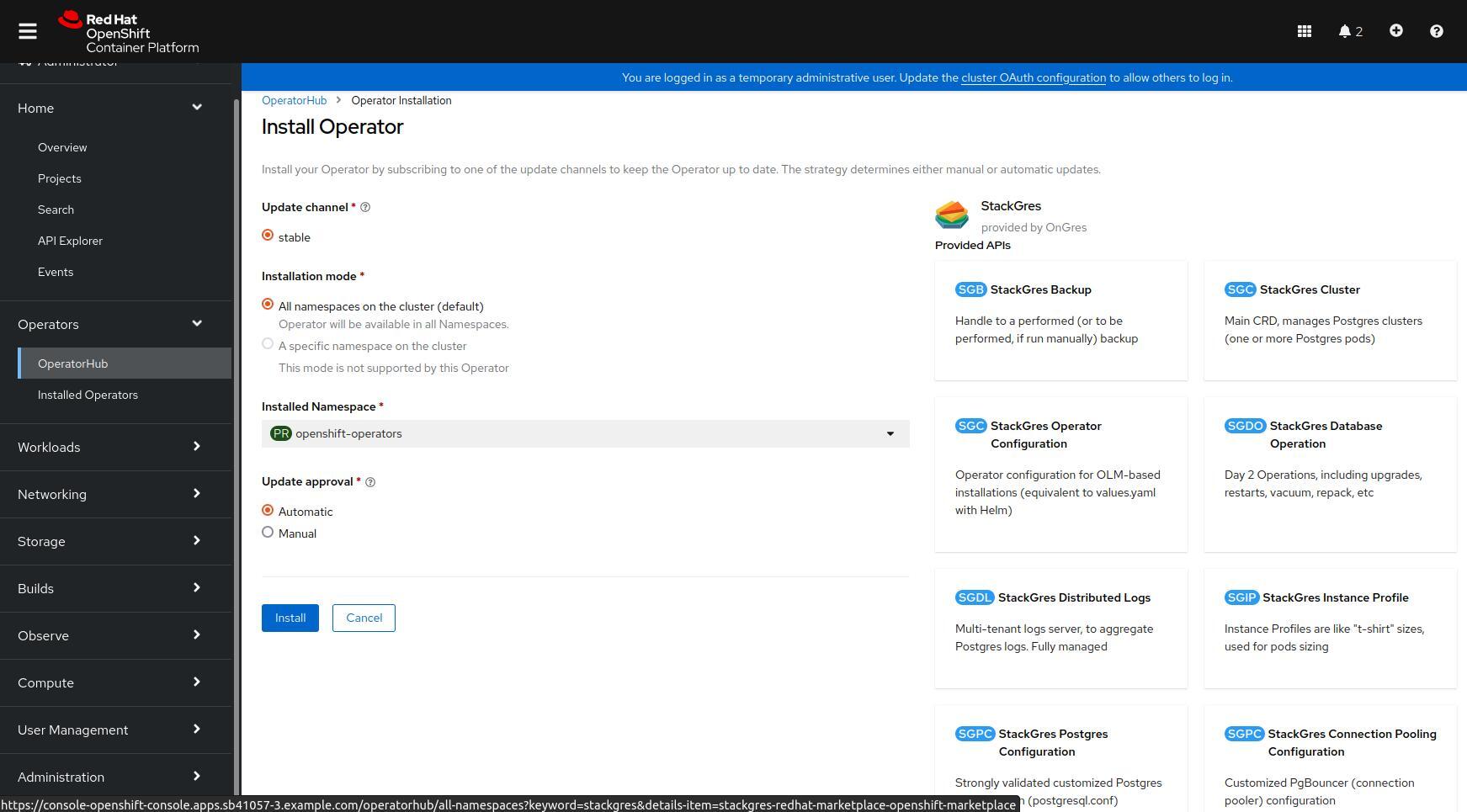Installation via OperatorHub
The StackGres operator can be installed via OperatorHub using the OLM (Operator Lifecycle Manager) that should already be installed in your Kubernetes cluster. On this page, we are going through all the necessary steps to set up a production-grade StackGres environment.
Installation via OperatorHub
StackGres (the operator and associated components) may be installed by creating the namespace, an operator group, and a subscription.
cat << EOF | kubectl create -f -
apiVersion: v1
kind: Namespace
metadata:
name: stackgres
---
apiVersion: operators.coreos.com/v1
kind: OperatorGroup
metadata:
name: stackgres
namespace: stackgres
---
apiVersion: operators.coreos.com/v1alpha1
kind: Subscription
metadata:
name: stackgres
namespace: stackgres
spec:
channel: stable
name: stackgres
source: operatorhubio-catalog
sourceNamespace: olm
installPlanApproval: Manual
EOF
You can specify the version in the startingCSV field. For example, you may set it to
stackgres.v1.0.0to install verion1.0.0.
The field installPlanApproval is set to Manual to prevent automatic upgrades of the operator in order to avoid having the operator upgraded before the StackGres custom resources are not upgraded to the latest version (for more info see the upgrade section).
To proceed with the installation you will have to patch the InstallPlan that has been created by the OLM operator:
kubectl get -n stackgres installplan -o name \
| while read RESOURCE
do
kubectl patch -n stackgres "$RESOURCE" --type merge -p 'spec: { approved: true }'
kubectl wait -n stackgres "$RESOURCE" --for condition=Installed
done
The installation may take a few minutes.
Finally, the output will be similar to:
installplan.operators.coreos.com/install-66964 patched
installplan.operators.coreos.com/install-66964 condition met
Modify the configuration by patching the StackGres SGConfig
cat << EOF | kubectl patch -n stackgres sgconfig stackgres --type merge -p "$(cat)"
spec:
grafana:
autoEmbed: true
secretName: prometheus-operator-grafana
secretNamespace: monitoring
secretPasswordKey: admin-password
secretUserKey: admin-user
webHost: prometheus-operator-grafana.monitoring
adminui:
service:
type: LoadBalancer
EOF
In some managed Kubernetes clusters and Kubernetes distribution a LoadBalancer may not be available, in such case replace
LoadBalancerforNodePortand you will be able to connect directly to the node port that will be assigned to the service. To retrieve such port use the following command:
kubectl get service -n stackgres stackgres-restapi --template '{{ (index .spec.ports 0).nodePort }}{{ printf "\n" }}'
Installation on OpenShift 4.x
On OpenShift 4.x, the operator will be installed in the openshift-operators namespace so make sure to replace stackgres with openshift-operators in all the commands of this tutorial.
Since in OpenShift the namespace openshift-operators is already created you only need to create the Subscription:
cat << EOF | kubectl create -f -
apiVersion: operators.coreos.com/v1alpha1
kind: Subscription
metadata:
name: stackgres
namespace: openshift-operators
spec:
channel: stable
name: stackgres
source: redhat-marketplace
sourceNamespace: openshift-marketplace
installPlanApproval: Manual
EOF
Alternatively you may install the StackGres Operator from the OpenShift Web Console by following these steps:
- Search the StackGres Operator from the OperatorHub tab >
- After selecting it click on the “Install” button >
- Then use the default setting and click on “Install” button >
To proceed with the installation you will have to patch the InstallPlan that has been created by the OLM operator:
kubectl get -n openshift-operators installplan -o name \
| xargs -I @RESOURCE kubectl patch -n openshift-operators @RESOURCE --type merge -p 'spec: { approved: true }'
The installation may take a few minutes.
To wait for the installation to complete use the command:
kubectl get -n openshift-operators installplan -o name \
| xargs -I @RESOURCE kubectl wait -n openshift-operators @RESOURCE --for condition=Installed
Finally, the output will be similar to:
installplan.operators.coreos.com/install-66964 condition met
Modify the configuration by patching the StackGres SGConfig
cat << EOF | kubectl patch -n openshift-operators sgconfig stackgres --type merge -p "$(cat)"
spec:
grafana:
autoEmbed: true
secretName: prometheus-operator-grafana
secretNamespace: monitoring
secretPasswordKey: admin-password
secretUserKey: admin-user
webHost: prometheus-operator-grafana.monitoring
adminui:
service:
type: LoadBalancer
EOF
In some managed Kubernetes clusters and Kubernetes distribution a LoadBalancer may not be available, in such case replace
LoadBalancerforNodePortand you will be able to connect directly to the node port that will be assigned to the service. To retrieve such port use the following command:
kubectl get service -n openshift-operators stackgres-restapi --template '{{ (index .spec.ports 0).nodePort }}{{ printf "\n" }}'


